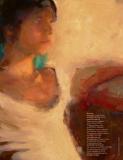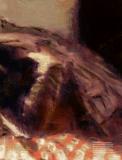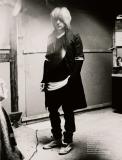WB: I don’t mean this as a negative, but do you you think your work is self-indulgent?
CS: I simply don’t try to be ironic or funny when painting and maybe a lot of us aren’t used to plain sincerity anymore. So, I guess yes, my work might seem self-indulgent to some.
WB: Your watercolors are much lighter in color and mood than your oils. Is it simply a function of the medium or is is a choice driven by a larger idea?
CS: It’s a mixture of both. On the one hand, this is due to the qualities of the materials, and on the other it’s the result of the process of painting itself. A watercolor needs only minutes to complete, whereas an oil painting needs days, maybe even weeks. Also, with watercolors the light comes from the paper as I progress from lighter tones into dark colors. When painting with oil, however, I have to apply the light afterwards and I kind of work from darkness into the light. These are two very different approaches to painting. Working with watercolors is fast, comparable to breathing, and sometimes I manage up to 30 paintings in a day. An oil painting requires excessive planning and is more of a conscious process.
While I personally don’t like using materials against their specific qualities, Elizabeth Peyton is very good at it. Her oils have the lightness of watercolors, however, I prefer highlighting the formal qualities of the materials I use.
WB: Your work is so focused on the surface of the models, their skin, and the surface of the paper. Is it important that we see your subjects below the skin?
CS: I spend a great deal of my time looking at pictures in the widest sense - it doesn’t make a difference whether I am looking at a painting by Velázquez or at a fashion magazine. The surface of a picture to me is never empty or dead, rather, I understand it as sensitive and even reactive. It answers according to how you treat it. However, I don’t think that my understanding of the ‘surface’ keeps me from questioning things or looking for something deeper.
The depth I am looking for is not metaphysical and it doesn’t ultimately lead to a ‘last truth’ or something like that. Rather, it is the depth of a body that is of interest to me. I want to explore what happens between the eye and the brain before an object is designated and consequently judged. Surfaces are boundaries and at the same time areas of contact between what is on the inside and what is on the outside. There is a difference between a surface and something superficial.
WB: Is it important that we see you below the skin? Is it important that your viewers understand anything about you personally?
CS: I think that would be asking too much, but generally I don’t have any presuppositions about that.
WB: How do you relax?
CS: Eating, swimming naked, sleeping, eating, swimming naked, sleeping…
WB: What are your three current favorite records?
Lykke Li - I’m Good, I’m Gone



































